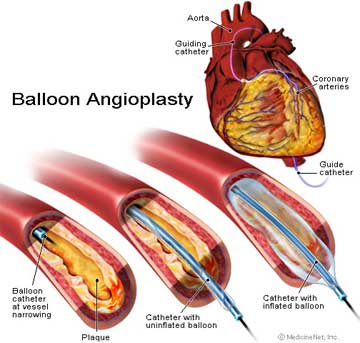|
What is Bypass surgery & Angioplasty
Main
Article page |
Beauty articles
|
Health page |
Computers|
Diseases |
Education |
Entertainment |
Family
Business |Fitness|
Fruits and Vegetables
|
Jobs |
General |
Personality|
Technology
|
Tourism |
Useful Tips
General Knowledge |
Biography Page|
Heroes & Incredible peoples
|
Inventions
Health Page|
Diseases and Remedies |
Articles
Coronary artery disease is a chronic condition in which the coronary
arteries, which carry oxygenated blood to the heart, become blocked due to
buildup of cholesterol. It is the most common form of cardiovascular disease.
Coronary artery disease develops gradually.
First, fatty plaque caused by cholesterol narrows the arteries. The plaque
begins to calcify which causes the arteries to become stiff and hard. This is
known as arteriosclerosis or hardening of the arteries. If left untreated, it
continues to worsen, eventually leading to a heart attack or cardiac arrest, and
very possibly, death.
Many people with coronary artery disease develop angina, which is chest pain,
or have no symptoms at all. Coronary artery disease is the most common cause of
death in our society
What are the symptoms of heart disease?
Symptoms can include angina, a discomfort caused by inadequate blood flow to
the heart, which causes pain in the chest, arms, neck or back. These symptoms,
if they become severe, last more than 10 to 15 minutes and are accompanied by
shortness of breath, nausea, sweating or fainting, could be signs of a heart
attack.
Women are more likely to experience only symptoms of nausea and vomiting
instead of the severe pain experienced by men when a heart attack occurs.
What can be done to prevent heart disease?
Although some risk factors such as family history, gender and age cannot be
controlled, there are a number of ways to help reduce the risk factors. These
include exercising regularly, maintaining a healthy weight, eating a “heart
healthy” diet by reducing the intake of foods high in cholesterol and saturated
fats, controlling high blood pressure and diabetes, not smoking, managing stress
and controlling chronic depression.
How is heart disease diagnosed?
Several tests can be done to diagnose possible heart disease. These can
include checking blood pressure, a chest x-ray and electrocardiogram to detect
any abnormalities of the heart, and blood tests, such as cholesterol and
triglyceride levels.
What treatments are available for heart disease?
There are many medications that your physician can prescribe to lower
cholesterol, lower blood pressure, and control symptoms of angina. If
medication, diet and exercise are not effective in treating the disease, and
arteries become blocked, open heart surgery may be performed.
Bypass surgery: Bypass surgery is a procedure in which a
healthy blood vessel is taken from another part of the body (usually the leg or
inside the chest wall) and is used to construct a detour around the blocked
artery. One end of the blood vessel is grafted directly below the blockage while
the other end is grafted directly above, allowing blood to flow to the heart. In
a double bypass surgery, two grafts are performed, in a triple, three grafts,
and in a quadruple, four.
Angioplasty: Balloon angioplasty is a procedure in which a catheter is
guided toward the blocked area in the artery. A second catheter with a small
balloon on its tip is passed through the first catheter. The balloon is inflated
when it reaches the blockage. This compresses the build-up of plaque and widens
the artery in order for the blood to flow. The balloon is then deflated and
removed.
What is an angioplasty?
A coronary angioplasty is a non-surgical procedure that uses a balloon
catheter to open up a narrowed section of a coronary artery that has been
blocked by plaque—a condition known as atherosclerosis that can lead to coronary
artery disease.
When the build-up of plaque narrows the arteries so much that only a small
amount of blood can flow through to the heart, chest pain (also known as angina)
can occur. Sometimes, a blood clot will completely block the blood flow to a
coronary artery causing a heart attack.
By opening blocked arteries, blood flow to the heart improves and the symptoms
of angina may be reduced and the chance of having a heart attack may decrease.
How is angioplasty done?
A doctor will insert a thin plastic catheter into an artery in your groin or
arm. The catheter is guided into the coronary artery then another catheter is
put through and a balloon is inflated. As the balloon is inflated it pushes the
plaque against the wall of the artery to open it.
What is a stent?
A stent is a small, coiled wire-mesh tube that is often inserted into the
coronary artery during the angioplasty procedure. The stent stays in the artery
and acts like a scaffold to prevent the artery from re-closing (restenosis).
There are two types of stents. One type is a regular stent and another type is
one that is coated with a medicine. Your doctor will determine the type of stent
that is best for you.
Will I need medication?
After your angioplasty, you will be prescribed an antiplatelet medication
called Plavix. Antiplatet medications are drugs that prevent blood from
clotting. This medication is prescribed for a minimum of one month and may be
prescribed for longer periods based on the type of stent.
What is cardiac rehabilitation?
Your doctor may recommend that you attend a cardiac rehabilitation program.
These programs provide heart health education and have an exercise component to
help you regain an independent lifestyle.
( Reference : American Healthcare Foundation
http://www.americanhealthcarefoundation.org, and Alberta Health services
http://www.capitalhealth.ca/ )
| 



